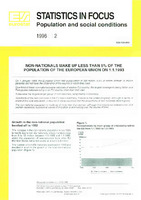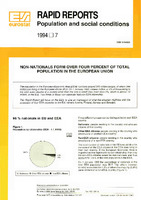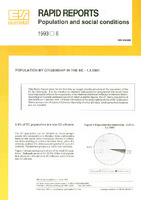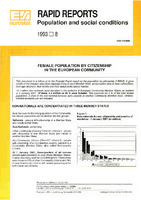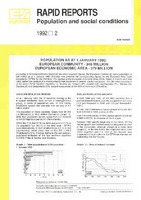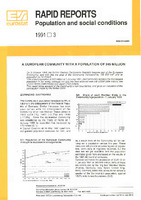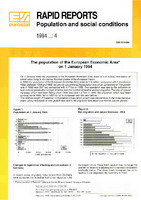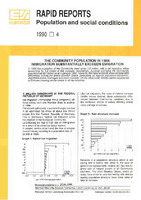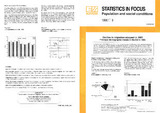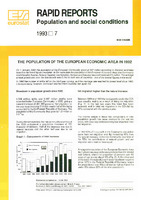Αναζήτηση
Αποτελέσματα 1-10 από 18
Statistics in Focus: Population and social conditions. Non-nationals make up less than 5% of the population of the European Union on 1.1.1993.
(Eurostat, 1996)
On 1 January 1993, the European Union had a population of 368 million, 4.8% of whom (almost 18 million persons) did not have the citizenship of the country in which they lived. One-third of these non-nationals were nationals ...
Rapid reports population and social conditions. Non-nationals forms over four percent of total population in the European Union.
(Eurostat, 1994)
Thepopulation in the European Economic Area (EEA) numbers around 370 million people, of whom 344 million are living in the European Union (EU). On 1 January 1992, sixteen million or 4% oí those living in the EEA were ...
Rapid reports population and social conditions. Population by citizenship in the EC -1.1.1991.
(Eurostat, 1993)
This Rapid Report gives for the first time an insight into the structure of the population of the EC by citizenship. It is the result of an intensive data collection programme that would have been impossible without the ...
Rapid reports Population and social conditions. Female population by citizenship in the european community.
(Eurostat, 1993-09)
This document is a followup to the Eurostat Rapid report on the population by citizenship (19936). It gives details of the females other than nationals living in each Member State, and provides data on their nationalities, ...
Rapid reports population and social conditions. population as at 1 January 1992: european community - 346 million european economic area - 379 million.
(Eurostat, 1992)
According to Eurostat estimates based on the latest available figures, the European Community had a population of 346 million as at 1 January 1992. Eurostat now presents the corresponding figures for the European Free Trade ...
Rapid reports population and social conditions. A european community with a population of 345 million.
(Eurostat, 1991)
On 3 October 1990, the former German Democratic Republic became part of the European Community, and with this the area of the Community increased by 108 000 krrr and its population by 16 million. With a totalpopulation ...
Rapid reports population and social conditions. The population of the European Economic Area* on 1 January 1994.
(Eurostat, 1994)
On 1January 1994 the population of the European Economic Area stood at 375 million, 349 million of whom were living in the twelve Member States of the European Union. In 1993 the population of the European Economic Area ...
Rapidn reports population and social conditions. The community population in 1989: Immigration substantially exceeds emigration.
(Eurostat, 1990)
In 1989 the population of the Community went up by 1.8 million, with a net migratory inflow accounting for 1.2 million of this increase. Accordingly, Eurostat estimates the Community population at 327 million as at 1 January ...
Statistics in Focus: Population and social conditions. Decline in migration stopped in 1995 Principal demographic trends in the EU in 1995.
(Eurostat, 1995)
During the period 1992-1994 the net inflow of international migrants to the European Union decreased drastically. After the 1992 peak of 1.3 million persons, net migration dropped to 1.0 million in 1993 and 0.8 million in ...
Rapid reports population and social conditions. The population of the European economic area in 1992.
(Eurostat, 1993-06)
On 1 January 1993 the population of the European Community stood at 347 million according to Eurostat estimates based on the latest figures available. At the same date the population of the European Economic Area (the ...

